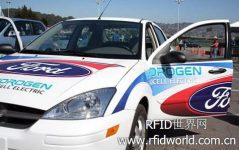
Florida uses wireless sensors to prevent leakage of hydrogen-powered cars
[ad_1]
As part of the fuel cell vehicle application project, Florida used ZigBee wireless sensor tags in Orlando to prevent gas leakage in 14 state hydrogen-powered vehicles. Users can log in to the website to view sensor data in real time. The system was designed and developed by the Department of Chemical Engineering of the University of Florida.
John Painter, the project manager in charge of the state’s hydrogen-powered fleet, said that the cost of this system is relatively low. With the increase in fuel cell vehicles, dealers can use it to ensure the safe storage and maintenance of vehicles. The fuel cell of this vehicle uses hydrogen and oxygen in the air to generate electricity. Because the node is composed of off-the-shelf components, the cost is very low. Only nodes, base stations, laptops and software are required to build a remote sensing system.

<1>Hydrogen powered car
Painter started as a fuel cell vehicle researcher at Ford Motor Company and was employed by the Florida government in 2006 to purchase and maintain fuel cell vehicles. There are 14 hydrogen fuel cells in Florida, some of which are used by the state environmental protection department, and the rest are owned by the public utility company Progress Energy.
Painter said that hydrogen is a highly explosive gas. Although the safety design of hydrogen-powered vehicles makes the vehicles safer than normal gasoline vehicles, Florida hopes to add a layer of safety precautions to ensure that hydrogen leakage can be detected in time. Due to frequent storms in this area, the vehicles were initially stored in an outdoor covered area of Progress Energy; when the vehicles were put into use, the state government chose to place the vehicles in the indoor work area to better protect them. However, this makes hydrogen leakage more dangerous because any leaking gas will accumulate in the sealed area.
Two years ago, Painter started discussing this project with local universities and companies, and met with Fan Ren, a professor of chemical engineering at the University of Florida, who has developed a hydrogen sensor AlGaN/GaN high electron mobility transistors (HEMTs) for NASA, and HEMT sensing The device measures the hydrogen content around the spacecraft, but it does not use any wireless transmission tools.
In August 2006, researchers installed 6 wireless sensor nodes in Greenway. NASA’s wired solution is not realistic here, Ren said, because the garage is large and wiring is difficult.
Each sensor node contains two hydrogen sensor chips and a ZigBee receiver that complies with the IEEE 802.15.4 wireless standard. The node measures the hydrogen content in the air every 5 seconds, and then transmits the measurement results directly to the base station, which is connected to the computer via a USB cable. The software on the computer reads the data and uploads it to the website, and Orlando officials can view the relevant data online. If the hydrogen content is higher than 1%, the base station can also trigger an alarm, Painter said, so far no leaks have been found.
Ren said that because hydrogen is lighter than air, it is easier to detect hydrogen on nodes installed on the ceiling above the vehicle. The nodes are plugged into an AC power source. If a power interruption occurs, the built-in battery of each node can also provide 30 days of power. The base station and computer are also equipped with back-end batteries.
At first the node contained only a hydrogen sensor, but the researchers found that temperature fluctuations in the garage would cause confusion in the reading results. Since higher temperature will cause a higher current reading of the sensor, and the current reading is very important for the hydrogen induction system, as a result, temperature fluctuations will affect the measurement of hydrogen. To solve this problem, the researchers installed two identical chips, both of which provide temperature sensing, but one of them does not provide hydrogen measurement, so the software system compares the two results to provide more accurate hydrogen content readings.
Ren said that the cost of this system is less than US$200, and if it is produced in large quantities, the cost will be lower.
[ad_2]




